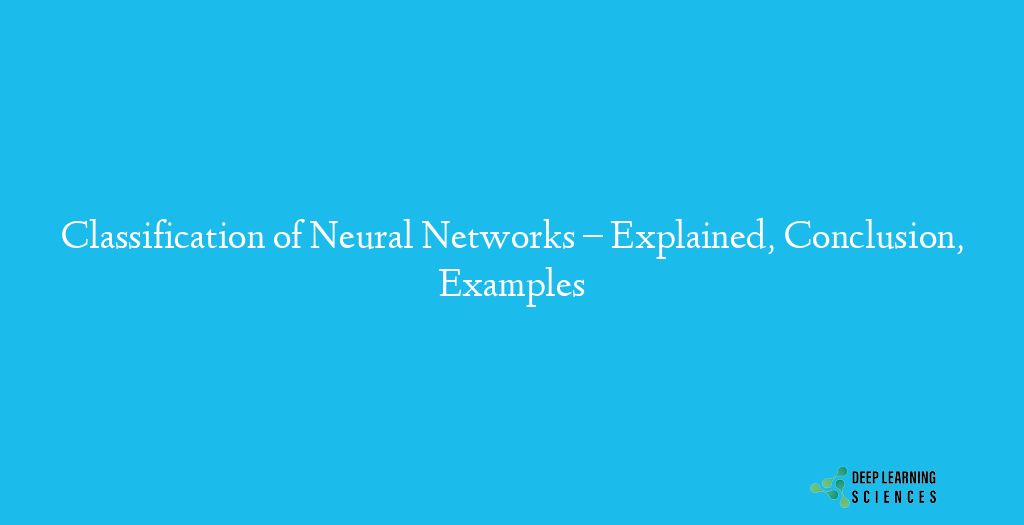Classification of neural networks used for the feature of the group is very similar to fault-diagnosis networks except that they only allow one output response for any input pattern, instead of allowing multiple levels of faults to occur for a given set of operating conditions.

Definition
Neural networks are a set of rules to be followed in calculations, modeled loosely after the human brain that is designed to recognize patterns and objects. They interpret transmitted data through a kind of machine perception, clustering raw input. The patterns they recognize are numerical, contained in vectors, into which all real-world data, be it images, text, time series, or sound, must be translated. It is their own expression to learn things. When we give a mathematical question human brain, does not solve it immediately, whereas when an assigned mathematical question computer solves it .and when you talk about the human mind, the human mind is there to recognize your image. If the shape of the world changes, its color changes, but the human mind recognizes it. There are three types of neural networks is following.
Neural networks help us cluster and classify. You can think of them as a classification and clustering layer on top of the data or information you store and manage. They help to group unlabeled raw fact and figure according to similarities among the example inputs, and they classify data when they have a labeled dataset to train on. (Neural networks can also extract features that are to another set of rules for classification and clustering; so you can think of neural networks as components of larger machine learning applications involving a set of algorithms for reinforcement learning, classification, or regression.)
How is classification done in neural networks?
A type of neural network classification is where multiple levels of classes are predicted. Neural networks, neural units are organized into three layers. The input layer of a neural network is composed of artificial input neurons and brings the occurring data into the system for further processing by subsequent layers of artificial neurons. The function applies weighted (Weight is the parameter within a NN (neural network) that transforms input data within the network’s hidden layers. A neural network is a series of nodes and neurons. Within each node are a set of weights, inputs, and a bias value. As an input enter the node, it gets multiplied by a weight value and the resulting output is either observed or passed to the next layer in the neural network. The neural network is composed of artificial input neurons and brings the initial raw fact into the system for further processing by hidden layers of artificial neurons. The output layer takes in input data which are processed from the layers before it, performs the calculations via its neurons, and then the information is computed.
Also Read: Division Operator in Python – A Complete Guide
What kind of problems does deep learning solve, and more importantly, can it solve yours? To know the answer, you need to ask a few questions:
What outcomes do I care about? In a classification problem, those outcomes are labels that could be applied to raw facts and figures: for example, spam or not spam in an email filter, bad_guy or good_guy in fraud detection, happy_customer or angry_customer in customer relationship management. Other types of problems include expected detection (useful in predictive maintenance and fraud detection of manufacturing equipment), and clustering, which is useful in suggestion systems that surface.
Using Neural in classification
Neural networks can be used for classification and regression problems. Under the regression model, one value is outputted which may be mapped to a set of real numbers meaning that only one output neuron is required. Neural networks help us cluster and classify. You can think of them as a classification and clustering layer on top of the data you store and manage. They help to group unstructured data according to similarities among the example inputs, and they classify data when they have a structured dataset to train on.
Conclusion:
Neural networks come out as one of a class of flexible non-linear regression methods that can be used to classify via regression. Some more interesting issues remain, including the assessment of the classifiers and algorithm development, and parameter estimation, Neural networks can help machines make intelligent decisions with limited human assistance. They can learn and model the relationships between input data and output data that are nonlinear and complex. They are good for Classification Optimization, and Pattern Recognition. This includes speech recognition, handwriting recognition, credit card fraud detection, face recognition, text translation, medical diagnosis, and solutions for huge amounts of data. You will most probably use a neural network when you have so much data with you, and accuracy matters the most to you. For Example, Cancer Detection. You cannot mess around with accuracy here if you want this is may use for actual medical applications. Keep visiting Deep Learning Sciences.